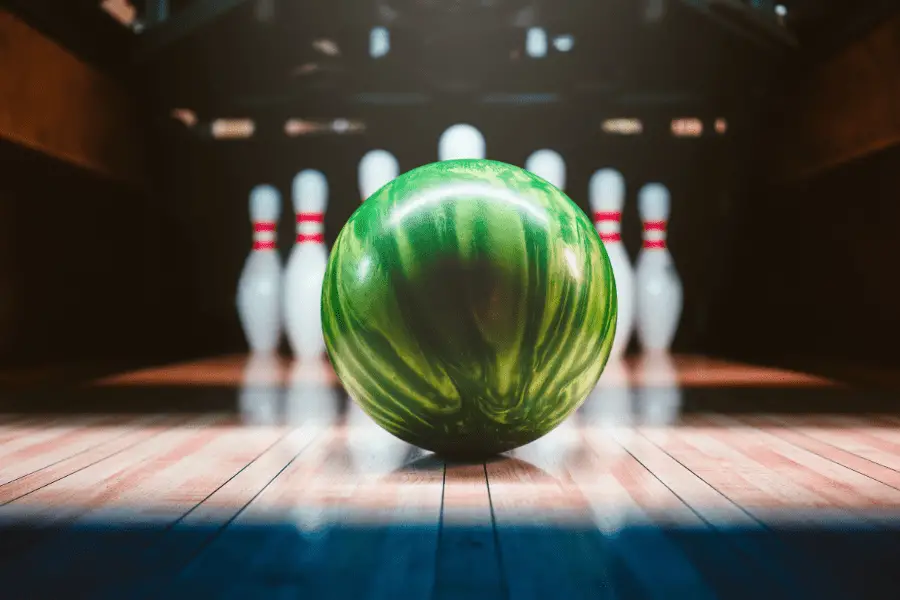
What is the most important thing in the bowling game? The pins? The lane? You? Nope. It’s the bowling balls that are the most important. But many people are confused which type of bowling ball works for them and which one to choose between urethane bowling ball and reactive resin ball. So I am here to overcome your confusion.
The main difference between Urethane bowling ball and Reactive resin bowling ball is the outer coverstock. Urethane bowling ball is made of urethan coverstock and reactive resin ball is made of an updated version of polyurethane coverstock that creates greater friction in the lane surface. Urethane bowling ball is best for great control and excellent predictability. If you dont have any urethane bowling ball in your arsenal I recommend you to grab Storm Pitch Bowling Ball. You can use it in both dry lanes and oily lanes.
On the Other Hand Reactive resin bowling ball is popular for high hook with excellent control. Storm phaze iii is undoubtedly best reactive resin ball I ever had in my arsenal. Go with it if you don’t have one.
Now lets discuss the differences in details.
The Material Building the Coverstock
In fact, there is a lot the material of the bowling ball that has to do with the style of the bowler. Not all bowling balls will suit the way you play. Some will be more compatible with you while others will make you feel like you can never do better.
So, the main three materials in vogue are plastic, urethane and Reactive Resin. Well, the whole of the bowling ball is not made of these materials, just the coverstock is. Apparently, the coverstock is the outer part- which comes in contact with the lane and the pins.
You could say it is also the most important part of the bowling ball. The core matters too but for now, let us focus on what has most people thinking. In order to know which shall win in the Urethane Vs Reactive Resin bowling balls battle for you, you have to know what each of them can do.
Urethane Vs Reactive Resin Bowling Balls: What they do.
Urethane Bowling Balls:
As you can guess by looking at the name, urethane bowling balls are made of a urethane coverstock. Now, it is the properties of urethane that makes it stand out. Apparently, these balls are easier to control on the lane.
urethane bowling balls is recognized as entry level bowling ball which provide very controllable skid distance on the front end and provide very low hook at the backend.
But they have better hooking ability than the plastic bowling balls. This is due to the presence of more pores in the body. The increased pores lead to increased friction- thus the hooking ability of the bowling ball is also increased.
Apparently, the greater friction also makes the ball deflect less. Thus, you can enjoy more forgiveness when you take the wrong shot. The ball will more or less go where you wanted it to go despite how horrible you are playing.
Reactive Resin Bowling Balls:
After Urethane bowling balls, the reactive resin balls are quite popular. Apparently, these balls have an even higher number of pores in them and thus they offer a greater amount of friction between the ball and the lane. The greater friction leads to a more sensitive ball to the lane conditions.
Thus, if there were 100 ways you could move the urethane ball on the lane, then there are 1000 ways you can move the reactive resin ball on the lane. This is mainly due to the fact that you can utilize each movement and each point of the lane to gain a different outcome.
The oil in front of the lane will make the ball move in one way and the oil at the back in another. This way you enjoy greater control over the ball. But, this control is harder to gain.
While the reactive bowling ball will not easily deflect, it will be hard to maintain the same level of speed and motion throughout the lane. You will have to practice and become very skilled to bowl with reactive resin bowling balls better.

Types of Reactive Resin Bowling Ball
Apparently, there are three kinds of reactive resin balls. Let’s check them out:
Reactive Solid Coverstocks:
As already mentioned, you can manipulate the course of the ball in various ways across the lane with a reactive resin ball. The reactive solid coverstocks are the ones that create a smooth back end motion. This is because the solid coverstocks react to the oil in the first portion of the lane.
Thus, it uses up its hooking potential at first and moves quite smoothly the rest of the way. So, if you want such a motion where you want the ball to move smoothly and fast at the end of the lane then the reactive solid coverstock is for you.
Reactive Pearl Coverstocks:
What separates it from the other type of reactive resin coverstock is the addition of Mica in it. The added material makes it less reactive to the oil on the front portion of the lane. As a result, the ball gives a consistent performance throughout and does not speed up at the back of the lane- it just gives you high performance.
So, if this is the kind of motion or path you are seeking then a reactive pearl coverstock is what you may be in need of.
Reactive Hybrid Coverstock:
Apparently, as literal as it may sound, the reactive hybrid coverstocks are a combination of the pearl and solid coverstocks. In fact, one part of it is pearl and the other solid. It gives a performance that falls between the separate performance of the two.
In other words, the reaction to the lane is quite balanced. Furthermore, each part has a different color.
Other Kinds
Plastic Bowling Balls:
There are bowling balls the coverstock of which is made of plastic. Apparently, these are for the completely not very serious players or for spare shots. The plastic balls do not really have much to none hooking potential. Plastic bowling is the best option for beginners and kids.
They just do the job of rolling and knocking the pins- nothing else. However, they are a great choice for very dry lanes- with almost no oil on the lane. There the plastic balls tend to move quite smoothly.
Other than that, they are quite cheap, durable and also available in a variety of colors.
Particle Bowling Balls:
The particle bowling balls were manufactured for a short while and probably are not manufactured anymore. Apparently, they do not even have pores but bumps in them. As a result, you can quite imagine the friction they are capable of creating. Thus, they are quite hard to control but once controlled they offer you a lot of control.
Urethane Vs Reactive Resin Bowling Balls: Which one is best for beginners?
Which one between urethane and reactive resin is good for bowlers, in general, depends on their style of playing. However, when it comes to beginners, it is best they start with the best Urethane bowling balls. While you do not want the game of bowling to be easy on you as you need to develop your skills- you cannot really play if it is too hard for you.
The Urethane bowling balls create a balance between too hard and too easy. They offer ample forgiveness while also give the bowler the right amount of control. Thus, the beginners get the motivation to play because he sees that it is nothing impossible.
Again, noticing that the game is not that easy either, the beginner tries harder to improve it. Another factor is the price. The urethane bowling balls are cheaper than the reactive resin ones. Thus, for a beginner who does not know if he will continue playing or not, the cheaper option is quite helpful.
Apart from all that, the reactive resin balls do not really last long. But, the urethane bowling balls do last. As a beginner, the bowler will need more practice and he will make more mistakes that can harm the bowling ball.
Thus, the ball needs to be more durable which the urethane balls are. Thus, for all these reasons the urethane bowling balls are more suitable for beginners.
On the other hand, the reactive resin balls become more suitable as the bowler advances through the various levels of bowling. In fact, they need to gain more control over the ball. At first, they will definitely fail with the reactive resin balls but with time, they will get a hang of it.
And, once they do, even the urethane balls will seem as easy as a piece of cake to handle. Thus, if you are a beginner, first just learn to bowl with a urethane ball. You can always move to a reactive resin later on.
Video: Reactive vs Urethane Bowling Balls
In conclusion
There are so many materials that can build up the coverstock of a bowling ball. And, you can quite see how just the materials can make a difference in how the ball acts on the lane. In fact, they can make a huge difference in the game as well.
As a beginner, it is best if you start by using a urethane ball. Then, when you feel confident enough, you can always pick up a reactive resin ball to further improve your game.

